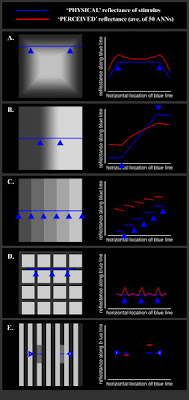[Disclosure of interest - there's a certain author on this paper that is married to the author of this piece...]
Take a look at the figure on the left (click on it to make it bigger). It's taken from a paper by Corney and Lotto. The left hand column shows some optical illusions that you've probably seen before. In Box A for example, the corner lines look lighter than they actually are, and in Box D, there is a tendency to see light spots appearing in the intersections of the darker grey lines.
In the right hand column, the blue line on the graph shows the actual lightness (reflectance) of the stimuli - that is, how much light is really being returned to the eye by the points along the blue line (assuming the blue line wasn't there!). The red curve shows the perceived reflectance - that is, how light the stimulus appears to be, once the brain is done processing the image in the light of prior experience.
Graph A shows the brain overestimating lightness throughout, but particularly at the points of maximum lightness - the "bands" in the corner that we see as being lighter than they really are. Graph D - my favourite - shows an oscillation: an intersection between two dark grey lines is perceived as lighter than it is (causing the appearing and disappearing "blobs" that we see). At the points furthest from these intersections, the line actually appears to be darker than it is.
Now for the sting: the brain in question was an artificial neural network (ANN) that only ever existed inside a computer. It was trained to successfully perform on a lightness constancy task. Most excitingly, when trained to discern between overlapping layers, the ANN sees White's illusion (Box E). White's illusion has been problematic to model as the lightness perception goes "the other way" from the stimuli shown here. Thus, the by-product of learning to see lightness and depth is a susceptibility to these illuaions. This also tells us something about how animal brains, including our own, work.
For the full article see Plos, and for a writeup see New Scientist.
Friday, September 28, 2007
Seeing things similarly
Posted by
Auntie Em
at
6:23 AM
![]()
Labels: clever folk, Cognition, Computers, Science
No comments:
Post a Comment